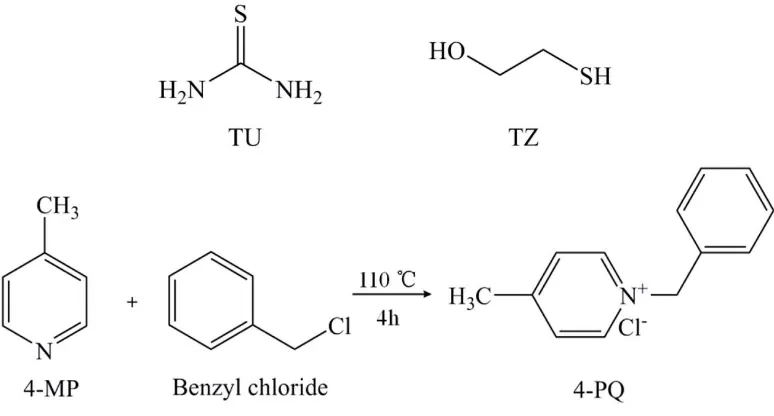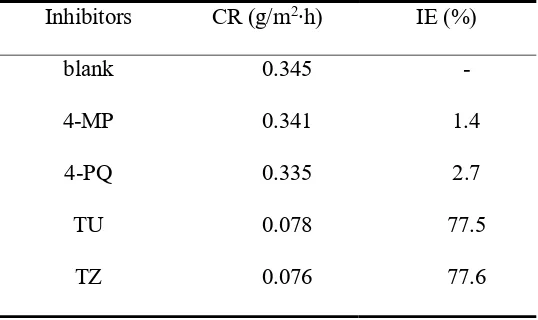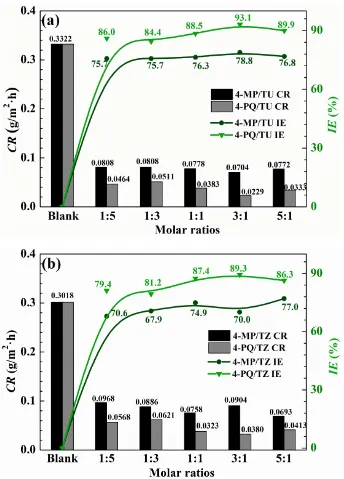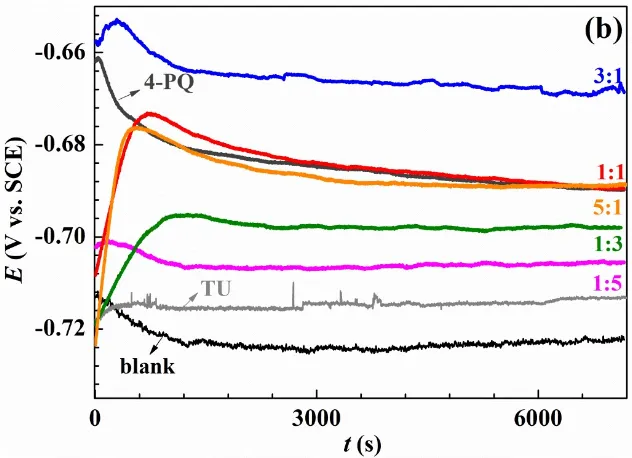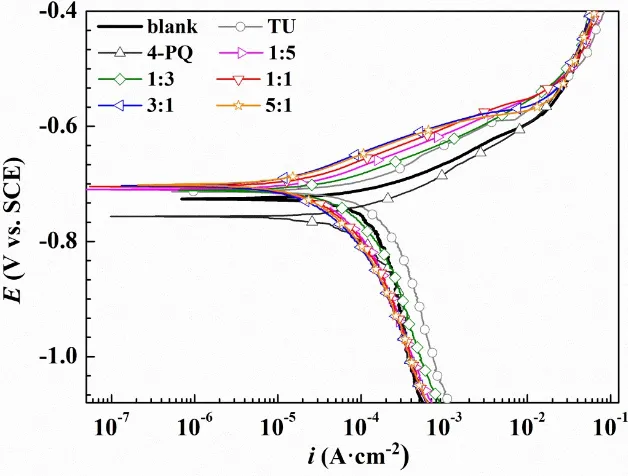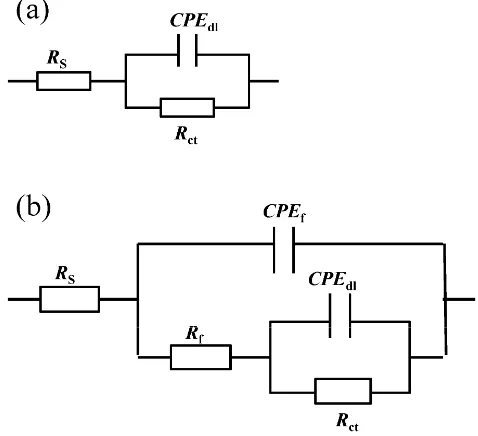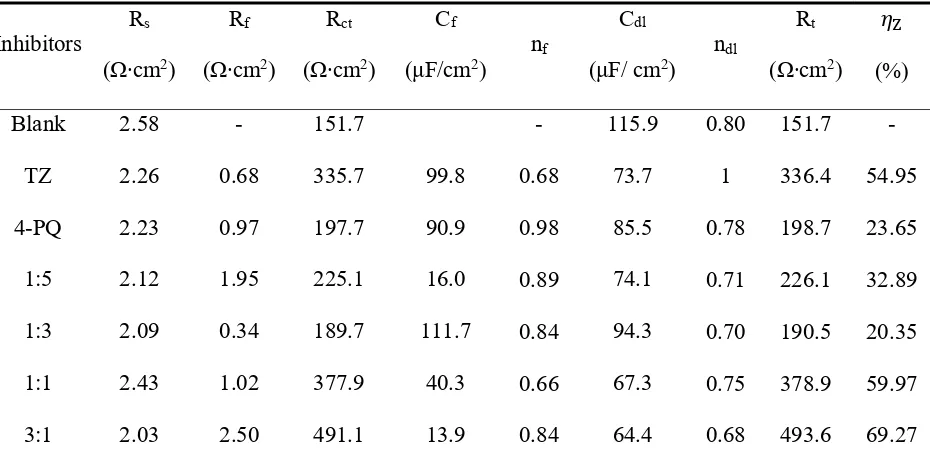Experimental and theoretical study on the synergistic inhibition effect of yridine derivatives and sulfur-containing compounds on the corrosion of carbon steel in
CO2-saturated 3.5 wt.% NaCl solution
Junlei Tanga, Yuxin Hua, Zhongzhi Hangb, Hu Wang*c, Yuanqiang Zhua, Yuan Wanga,
Zhen Nied, Yingying Wanga
a School of Chemistry and Chemical Engineering, Southwest Petroleum University, Chengdu 610500, China
b CNPC Engineering Technology Research Company Limited., No.40 Jintang Road. Tanggu Binhai New Area, Tianjin 300451, China
c School of Material Science and Engineering, Southwest Petroleum University, Chengdu 610500, China
d Research Institute of Petroleum Exploration and Development, CNPC, Beijing 100083, China
Tel./fax: plus 86 028 83037361 senty78@126.com
Abstract
The corrosion inhibition performance of pyridine derivatives (4-methylpyridine and its quaternary ammonium salts) and sulfur-containing compounds (thiourea and mercaptoethanol) with different molar ratios on carbon steel in CO2-saturated 3.5 wt.% NaCl solution was investigated by weight loss, potentiodynamic polarization,
electrochemical impedance spectroscopy and scanning electron microscopy. The synergistic corrosion inhibition mechanism of mixed inhibitors was elucidated by the theoretical calculation and simulation. The molecule of pyridine derivatives compound with larger volume has the priority to adsorb on the metal surface, while
the molecules of sulfur-containing compounds with smaller volume fill in vacancies. A dense adsorption film would be formed when 4-PQ and sulfur-containing compounds are added at a proper mole ratio.
Keywords: Corrosion inhibitor; Synergistic effect; Electrochemical measurements; Theoretical calculation
1. Introduction
Carbon dioxide (CO2) corrosion is a serious problem in oil and gas wells and pipelines causing unacceptable electrochemical corrosion of carbon steel, especially in oil and gas production and transmission [1–4]. Due to low-cost and convenient, the injection of inhibitors is an economical and effective method for corrosion protection [5,6]. In general, corrosion inhibitors for carbon steel used in oilfield industry are organic compounds contain unsaturated bond or atoms such as N, O, S, etc. They can form coordination bonds with empty orbits of metal elements, and adsorb on the metal surface to protect metal material [7–9].
The corrosion inhibitor of single compound is often insufficient to protect carbon steel tubing and casing for oil production because of severe corrosive environment. The development of inhibitors mixture with a synergistic inhibition effect is the economical and effective way for increasing the inhibition efficiency, decreasing the amount of usage and diversifying the application of inhibitors in aggressive medium
derivatives as one of the important classes of pharmacological compound are widely used in medical industry and some literatures revealed pyridine derivatives were used as corrosion inhibitors having desirable effect in acid solutions. Researchers probed the special structure of those compounds to bridge between the experimental results and theoretical studies by quantum chemical studies [18–20]. Their corrosion inhibition effect could be owing to the heterocyclic structure with nitrogen atom [21– 23]. However, it has rarely been studied in CO2 environment. In another hand, sulfur compounds such like thiourea and mercaptoethanol have the protective effect for carbon steel determined by concentration and corrosion medium [24–26]. However, the dosage cost limit its further application. It is able to design economical and effective corrosion inhibitors mixtures if there is an efficient synergistic inhibition effect between pyridine derivatives and sulfur-containing compounds, which haven’t been systematic investigated to the best of our knowledge.
More important, the classical adsorption model of mixed corrosion inhibitors which had the synergistic effect, considering the adsorption mechanism was that the inhibitor molecule with strong bonding preferentially adsorbed on the metal surface by the way of erect or tilted arrangement, and another inhibitor was superimposed on the void to form a coherent hydrophobic film as a barrier for migration of corrosive medium [27,28]. At present, although this typical theoretical model is widely accepted, the real adsorption configuration at the metal/solution interface is very difficult to be confirmed by the in-situ microscopic characterization in
(in aqueous solution, molecular concentration, different ratios of the two molecules) are reported very rarely [29–31]. However, the number of molecules in the unit volume, H2O molecules and the interaction between different corrosion inhibitor molecules have important influences on the adsorption behavior. Therefore, the molecular dynamics simulation of the corrosion inhibitors mixture considering the H2O molecule, corrosion inhibitor composition and concentration should be addressed.
In this paper, a derivative of pyridine, 4-methylpyridine (4-MP) and its quaternary ammonium salts (4-PQ), and sulfur-containing compounds including thiourea (TU) and mercaptoethanol (TZ) were selected to deduce synergistic effect in CO2-saturated 3.5 wt.% NaCl solution by weight-loss method, open circuit potential (OCP), electrochemical impedance spectroscopy (EIS), potentiodynamic polarization and scanning electron microscopy (SEM). The synergistic mechanism was proposed based on the electrochemical results analysis, quantum chemical parameters calculation and molecular dynamics (MD) simulation.
2. Experimental 2.1 Materials
The molecular structures of 4-MP, 4-PQ, TU and TZ and the synthesis method are shown in Fig. 1. 4-PQ was synthesized by chemical reaction between 4-MP and benzyl chloride at 110°C for 4 hours.
Test specimen used in this study was Q235 steel with the following composition
Fig. 1. Molecular structures of TU, TZ, 4-MP, 4-PQ and chemical reaction of quaternization.
2.2 Weight loss measurement
The carbon steel sheet of 40mm×13mm×2mm was abraded with a range of sandpaper (grade 280, 500, 1000) gradually, washed with deionized water, acetone, anhydrous ethanol, and then dried with a cold drier. After weighing by electronic analytical balance with sensitivity of ±0.1 mg. Then putted the sample into 100 ml corrosion solution containing with different inhibitors which deoxidized with N2 for 0.5 hours and then saturated with carbon dioxide gas at atmospheric pressure by bubbling carbon dioxide for 0.5 hours at 60±1°C for 72 hours. After taking out the sample, immersed in the acid bath for a short time to remove the corrosion product, then cleaned, dried and re-weighed accurately.
The corrosion rate (CR) and inhibition efficiency (IE) were calculated from the following equation:
IE=CR0-CRinh
CR0 × 100% (2)
where ΔW is the average weight loss of three coupons, S is the sample area and t
is the immersion time, CR0 and CRinh are the corrosion rate with and without
inhibitors, respectively.
2.3 Electrochemical measurement experiments
All the electrochemical measurements were carried out on a Corr Test
electrochemical workstation (Wuhan Corrtest Instruments Corp. LTD CS350), received and output experimental data by connecting computer software CorrTest (Ver 4.5). In this study, a conventional three electrodes test was carried out at 60°C, the working electrode (WE) is a cylindrical electrode wrapped in Teflon through the machine processing and the exposed test area was 0.5 cm2. The saturated calomel electrode (SCE) was used as reference electrode (RE) through the connecting salt bridge, a platinum plate with a certain area was used as a counter electrode (CE). Before each experiment, the work electrode was polished by sandpaper (grade 500, 1000, 2000), dried with a cold drier after rinsing with deionized water and alcohol. The three electrode system was placed in the glass cell containing 100 mL test solution pumped N2 for 0.5 hours to remove oxygen, then continuously bubbled steady flow of CO2 throughout the experiment with and without corrosion inhibitors in the solution.
efficiency (𝜂 and 𝜂 ) was calculated from potentiodynamic polarization and EIS by
means of the following equations, respectively:
ηP=Icorr(0)-Icorr(inh)
Icorr(0) × 100% (3)
ηZ=Rt(inh)-Rt(0) Rt(inh)
× 100% (4)
where Icorr(0) and Rt(0) represents corrosion current density and total resistance in the absence of inhibitors, Icorr(inh) and Rt(inh) stands for corrosion current density and total resistance of different inhibitor systems.
To study the order of adsorption in synergistic effect, polarization resistance tests were performed for different sequence of adding the one inhibitor at intervals of 40 minutes under a potential range from –10 mV to +10 mV (vs. OCP) at sweep rate of 0.2 mV s-1at 10 minutesinterval.
2.4 Surface analysis
The carbon steel sheets of 40mm×13mm×2mm were immersed in CO2-saturated 3.5 wt.% NaCl solution without and with 2×10-4 mol/L mixed inhibitors of 4-PQ and TU (or TZ) which the molar ratio is 3:1 at 60°C for 72 hours, washed by deionized water, dried with a cold drier and then tested by SEM (EVO MA15, ZEISS).
2.5 Computational details
The M06-2x hybrid functional method were used to optimize the geometric structure of the inhibitor and calculate the quantum chemical parameters through the Gaussian 09 software package. The relevant quantum chemical parameters including energies of LUMO (ELUMO) and HOMO (EHOMO), energy gap (ΔE), absolute chemical hardness (η), electrochemical potential (μ), electronegativity (χ), the number of electron transfer (ΔN), electrophilicity index (ω) for four inhibitors were considered.
Materials Studio 8.1 software. The Geometry optimized function was used to optimize the geometry of five combinations containing 4-PQ and TU at different molar ratios in the water - Fe (1 1 0) surface system under the force field of COMPASS, making the entire system configuration more reasonable. Smart optimization algorithm was selected included the convergence standard was set to 2×10-5 kcal/mol and the maximum number of optimized steps was 20000 steps. The molecular dynamics (MD) simulation using the dynamics function to study the interaction between five combinations and Fe (1 1 0) surface in a simulation box (27.3 Å×27.3 Å×120.5 Å)with periodic boundary conditions to model a representative part of the interface devoid of any arbitrary boundary effects. Normal ensemble (NVT) was selected, and the Andersen thermostat was used to control the temperature at 333 K. The initial velocity of each particle was generated by the Maxwell-Boltzmann distribution and the Newton's equation of motion was calculated by the Velocity Verlet algorithm. The van der waals interaction and electrostatic effect were calculated by the Atom Based method and the Ewald method under 15 Å cut-off distance, respectively.
3. Results and discussion 3.1 Weight loss measurements
The corrosion inhibition effect of 4-MP, 4-PQ, TU, TZ and their mixture with different molar ratios at 2×10-4 mol/L for Q235 steel in CO2-saturated 3.5 wt.% NaCl solution were studied by weight loss test at 60°C for 72 hours immersion, as shown in
Fig. 2, it indicates that the synergistic effects of 4-PQ with sulfur-containing compounds are better than that of 4-MP.The IE% of the compounded inhibitors are much higher than the sum of the IE% of individual 4-PQ and TZ or TU. The maximum values of IE% reach 89.3% and 93.1% when the molar ratio of 4-PQ and TZ or TU are all 3:1. For the synergistic system of 4-PQ and sulfur-containing compounds, the value of IE% is reduced with the molar ratio of sulfur-containing compounds increased.
Table 1. Corrosion rate and inhibition efficiency obtained from weight loss measurement of Q235 steel with different individual inhibitor in CO2-saturated 3.5 wt.% NaCl solution at 60°C.
Inhibitors CR (g/m2∙h) IE (%)
blank 0.345 -
4-MP 0.341 1.4
4-PQ 0.335 2.7
TU 0.078 77.5
Fig. 2. Corrosion rate and inhibition efficiency obtained from weight loss measurement of Q235 steel with different mole ratios of (a) 4-MP (4-PQ)/TU and (b) 4-MP (4-PQ)/TZ in CO2-saturated 3.5 wt.% NaCl solution at 60°C.
3.2 Open circuit potential monitoring
Fig. 3. Variation of the open circuit potential with immersion time recorded of Q235 steel in CO2-saturated 3.5 wt.% NaCl solution at 60°C without and with (a) single inhibitor 4-PQ or TZ, and different molar ratios of 4-PQ and TZ; (b) single inhibitor 4-PQ or TU, and different molar ratios of 4-PQ and TU.
3.3 Potentiodynamic polarization
In order to further assess the synergistic effects between 4-PQ and sulfur-containing compounds, potentiodynamic polarization experiments were conducted for Q235 steel without and with 2×10-4 mol/L inhibitors at different mole ratios in CO2-staturated 3.5 wt.% NaCl solutions at 60°C. Fig. 4 and Fig. 5 shows the
Fig. 4. Polarization curves of Q235 steel in CO2-saturated 3.5 wt.% NaCl solution with or without different mole ratios of 4-PQ and TZ or individual inhibitor at 60°C.
Table 2. Polarization parameters of Q235 steel in CO2-saturated 3.5 wt.% NaCl solution with or without different mole ratios of 4-PQ and TZ or individual inhibitor and at 60°C.
Inhibitors ba (mV) -bc (mV) Ecorr(V) Icorr(µA∙cm-2) 𝜂 (%)
Blank 70 557 -0.726 136.7
TZ 193 379 -0.717 59.3 56.6
4-PQ 80 412 -0.756 114.6 16.2
1:5 63 173 -0.713 56.5 58.6
1:3 82 181 -0.725 90.9 33.5
1:1 95 177 -0.710 50.3 63.2
3:1 60 107 -0.703 28.4 79.2
5:1 110 165 -0.711 48.2 64.7
Table 3. Polarization parameters of Q235 steel in CO2-saturated 3.5 wt.% NaCl solution with or without different mole ratios of 4-PQ and TU or individual inhibitor at 60°C.
Inhibitors ba (mV) -bc (mV) Ecorr(V) Icorr(µA∙cm-2) 𝜂 (%)
blank 70 557 -0.726 136.7
TU 193 379 -0.714 69.2 49.4
4-PQ 80 412 -0.756 114.6 16.2
1:5 68 188 -0.710 43.4 68.2
1:3 67 206 -0.711 50.2 63.3
1:1 73 172 -0.705 28.3 79.2
3:1 79 159 -0.703 20.5 85.0
5:1 82 169 -0.701 24.1 82.3
suppressed the anodic process of corrosion. Table 1 indicates corrosion current density (Icorr) values of 1:1, 3:1 and 5:1 have a more remarkable decline than blank and individual inhibitor. Especially, the highest inhibition efficiency reaches 79.2% at the molar ratio is 3:1.However, when the molar ratio of 4-PQ and TZ is 1:3 or 1:5, the inhibition efficiency is better than adding 4-PQ alone, but lower than adding TZ alone. Therefore, 4-PQ needs to add a certain amount to promote synergistic effect in the composite inhibitors.
From Fig. 5 and Table 3, the polarization curve results of 4-PQ and TU are similar to the mixture of 4-PQ and TZ, but the synergistic inhibition efficiency is better than 4-PQ and TZ. Various of cathodic curves overlap with the blank, however, the shape of anodic curves changes greatly. The anode curve reflects the action of inhibitors. These can be divided into three regions, the slopes rapidly increases in the
first region (<100mv vs OCP), and this process shows that the inhibitors adsorbs on
the metal surface and hinders the metal dissolution reaction of the anode. The second region (100~150mv vs OCP) has a slow growth potential and reflects the dynamic
adsorption process of inhibitors on the metal surface. The third area (>150mv vs
obtained by polarization test show a good agreement with weight loss method. 3.4 Electrochemical impedance spectroscopy measurements
Fig. 6. Nyquist (a), (b) and (c), (d) Bode plots of Q235 steel in CO2-saturated 3.5 wt.% NaCl solution with or without different mole ratios of 4-PQ and sulfur-containing compounds or individual inhibitor at 60°C.
Simultaneously, phase angle plot were observed to follow similar trend as Nyquist and Bode plots. Fig. 7 shows an equivalent circuit diagram of blank solution (Fig. 7a) and an equivalent circuit diagram of two time constants used to fit data well for solution containing mixed corrosion inhibitors (Fig. 7b). Here, Rs stands for the solution resistance, Rct is the charge transfer resistance, Rf represents the resistance of the protective inhibitor film formed on Q235 surface, CPEdl and CPEf represent constant phase element of double layer and constant phase element of adsorption film, respectively [11,35,36]. The extracted parameters from EIS are summarized in Table 4 and Table 5. The values of Cdl and Cf are calculated from Y0 and n as follows [37,38]:
C = 𝑌 (2π𝑓 )
where Y0 represents the magnitude of the CPE, fmax is the frequency at the maximum value of the imaginary component of the impedance spectrum, and n is the deviation parameter in regard to the phase shift.
and mixture of 4-PQ and sulfur-containing compounds.
The values of Rf and Rct are increased with the addition of composite inhibitors compared to the blank solution. Further, the value of Rt (Rf +Rct) reached the maximum when the content of 4-PQ makes the proportion reached 3:1 with sulfur-containing compounds. On the other hand, the minimum value of Cdl indicates that the thickness of the double layer is increased to the maximum or the dielectric constant is reduced to the minimum due to the adsorption of the inhibitor [38]. The mixture of 4-PQ and TU has better performance and inhibition efficiency reaches 82.8% at 3:1, it implies the corrosion inhibitors formed complete and dense film by the two substances. All of above results reveal the synergistic effect of 4-PQ with sulfur-containing compounds depends on molar proportion of composite inhibitors.
Table 4. Equivalent circuit parameters and inhibition efficiency (IE) obtained from EIS measurements of Q235 steel in CO2-saturated 3.5 wt.% NaCl solution with or without different mole ratios of 4-PQ and TZ or individual inhibitor at 60°C.
Inhibitors
Rs (Ω∙cm2)
Rf (Ω∙cm2)
Rct (Ω∙cm2)
Cf
(μF/cm2) nf
Cdl
(μF/ cm2) ndl
Rt (Ω∙cm2)
𝜂
(%)
Blank 2.58 - 151.7 - 115.9 0.80 151.7 -
TZ 2.26 0.68 335.7 99.8 0.68 73.7 1 336.4 54.95
4-PQ 2.23 0.97 197.7 90.9 0.98 85.5 0.78 198.7 23.65
1:5 2.12 1.95 225.1 16.0 0.89 74.1 0.71 226.1 32.89
1:3 2.09 0.34 189.7 111.7 0.84 94.3 0.70 190.5 20.35
1:1 2.43 1.02 377.9 40.3 0.66 67.3 0.75 378.9 59.97
5:1 2.28 1.76 410.0 24.7 0.66 73.5 0.93 411.8 63.17
Table 5. Equivalent circuit parameters and inhibition efficiency (IE) obtained from EIS measurements of Q235 steel in CO2-saturated 3.5 wt.% NaCl solution with or without different mole ratios of 4-PQ and TU or individual inhibitor at 60°C.
Inhibitors Rs (Ω∙cm2)
Rf (Ω∙cm2)
Rct (Ω∙cm2)
Cf
(μF/ cm2) nf
Cdl
(μF/ cm2) ndl
Rt (Ω∙cm2)
𝜂
(%)
Blank 2.58 - 151.7 - - 115.9 0.80 151.70 -
TU 2.03 1.54 323.2 21.1 0.71 57.0 0.86 324.74 53.06
4-PQ 2.23 0.97 198.7 90.9 0.98 85.5 0.78 199.67 23.65 1:5 2.47 1.47 363.5 46.3 0.81 89.9 0.79 364.97 58.47 1:3 2.23 2.56 349.9 54.9 0.79 37.6 0.78 352.46 56.96
1:1 2.28 1.77 599.6 5.7 0.92 56.4 0.70 601.37 74.76
3:1 2.44 2.66 879.6 1.3 0.60 42.5 0.72 882.26 82.80
5:1 2.04 1.66 759.50 18.8 0.79 51.2 0.72 761.16 80.12
3.5 Synergistic mechanism
near to curve 4 at the beginning. However, all curves expect blank solution (curve 1) are stabilized at the close-set positions and all the solutions contained 2×10-4 mol/L mixed inhibitors of 4-PQ and TU with 3:1 in the end.
blank and adding corrosion inhibitors mixture contained 4-PQ and TU at the beginning, respectively. Curve 2 represents adding TU at beginning, then adding 4-PQ at the time of 40th minutes. Curve 3 represents adding 4-4-PQ at beginning, then adding TU at the time of 40th minutes.
The resistance curves ofdirect current polarization measured for 4-PQ and TU of 3:1 with different addition sequence are shown in Fig. 8(b). As seen in Fig. 8(b), the value of polarization resistance (Rp) of the corrosion inhibitors mixture added at t=0 min remained constant (785 Ω∙cm2) during the test, and is closed to Rt from the impedance test results [39]. In the first 40 minutes of adding single corrosion inhibitor, the Rp is lower than the mixed corrosion inhibitors. The Rp of adding single 4-PQ that makes up three quarters of 2×10-4 mol/L is 458 Ω∙cm2, and then TU is added at the 40th minute, which the curve of Rp shifted steep immediately. Ultimately, the steady value is consistent with the curve of addition together at the beginning. On the other hand, the Rp of a quarter of 2×10-4 mol/L single TU is stable at 280 Ω∙cm2, and then added another inhibitor 4-PQ, the Rp increases a bit and is lower than the previous situation.It reveals the concentration of TU is too low to form the dense inhibitor film on the metal surface after preferential addition, and further formed the crystalline compound with adding 4-PQ which accumulated above the film of TU [40], and 4-PQ cannot fill the active site to form a dense inhibitor film, resulting in the resistance is much lower than mixtures. All of above results indicate adsorption order has an effect
on the synergistic effect of composite inhibitors. 3.6 Scanning electron microscopy characterization
absence and presence of the optimum mole ratio of mixed inhibitors. The Fig. 9(a) and (b) are blank solutions and added single 4-PQ in solution, respectively, (c) and (d) are the mixture of 4-PQ and sulfur-containing compounds with molar ratio of 3:1. It can be seen that homogeneous corroded area are observed on the sample surface in the blank solution (without corrosion inhibitors), as the same as added single 4-PQ. The surface of the sample immersed in solution with mixed inhibitors is smooth and uniform, the corrosion degree is slowed down significantly. It illustrates that mixed inhibitors of 4-PQ and sulfur-containing compounds with the molar ratio of 3:1 formed a compact protective film on the surface of Q235 steel, inhibiting the corrosion of carbon steel in this medium.
3.7 Quantum chemical calculation
Quantum chemical calculation is a useful method to explain the theory of the adsorption of corrosion inhibitor molecules on the metal surface and the interaction between molecules. The parameters from quantum chemical calculation can be used to describe the global reaction activity of inhibitor molecules, included the highest occupied molecular orbital (HOMO), lowest unoccupied molecular orbital (LUMO). It is easier to give electrons with the value of EHOMO increasing. For another,the lower of ELUMO indicates the energy decreases to accept the electron easily [41].
Fig. 10. Schematic representation of HOMO and LUMO molecular orbital of pyridine derivatives and sulfur-containing compounds (Color code: N, blue; S, yellow; C, gray; H, white).
Table 6. Calculated quantum chemical indices of pyridine derivatives and sulfur-containing compounds.
3.8 Molecular dynamics simulation
Inhibitor EHOMO ELUMO ∆E η w ∆N χ μ
Molecular dynamics simulations of the adsorption process of corrosion inhibitors mixture on Fe (1 1 0) surface under different condition are presented in Fig. 11. The MD simulation further proves the adsorption ability and configurations of these inhibitors at different molar ratios on metal surfaces. The side views of 4-PQ and TU reveals that the total number is 12 with the ratio of 1:5, 1:3, 1:1, 3:1, and 5:1 respectively. Some corrosion inhibitors are free in aqueous solution while the others are adsorbed on the Fe (1 1 0) surface at different molar ratios. The nitrogen-containing heterocyclic of 4-PQ provides the lone pairs of electrons to form covalent bonds with empty orbitals of iron, and flat adsorbs the active sites of the metal surface. The N and S atoms in the TU structure also play the same role.
It can be seen from the coverage degree of iron-based surface that the corrosion inhibitors mixture with molar ratio of 3:1 can achieve the maximum coverage and 1:3 is the minimum coverage. In addition, the adsorption stability of corrosion inhibitor molecules is studied by the adsorption energy of the corrosion inhibitor molecules. The higher absolute value of the adsorption energy implies the adsorption of the inhibitors is more stable on the metal surface, the inhibition effect is better and these inhibitor molecules have the stronger synergy. Adsorption energy (Eadsoption) is calculated as follows [43,44]:
Eadsoption=Etotal-(Esurface+solution+Einhibitors+solution)-Esolution
where Etotal is the total energy of the simulation system includes the iron crystal together with the adsorbed inhibitor molecules on the iron surface and the solution;
Esurface+solution stands for the total energy of the system without the inhibitors;
Einhibitors+solution is the total energy of the system without the iron crystal; and Esolution is
Fig. 11. Side views of the lowest energy adsorption configurations of 4-PQ and TU with different molar ratios (a) 1:5, (b) 1:3, (c) 1:1, (d) 3:1 and (e) 5:1 on Fe (1 1 0) calculated by MD simulations.
4-PQ:TU Etotal Esurface+solution Einhibitors+solution Esolution Eadsoption
1:5 -41105.7 -39365.3 -8953.9 -7518.03 -304.495 1:3 -40974.3 -39389 -8823.87 -7536.58 -297.995 1:1 -40556.2 -39237.3 -8347.31 -7508.61 -480.2 3:1 -39985.6 -38771.2 -7734.12 -7083.08 -563.43 5:1 -39856.7 -38861.6 -7606.54 -7157.9 -546.394
Fig. 12. Concentration profile for water molecules on the metal surface as a function of height with corrosion inhibitors at different molar ratios.
shows that 4-PQ and TU have a high coverage at a molar ratio of 3:1 on the iron surface, which hinders the adsorption of water molecules and play a good protective effect. Rather, the number of large molecular that are adsorbed on the metal surface increasing lead to appear the voids under the molar ratio of 5:1, so that the small molecule cannot be filled and the water molecules concentration increases. The concentration profile of water molecules in the region of 3.8~4.8 Å from Fe (1 1 0) surface appears a trough with addition of inhibitors at different molar ratios, especially the concentration value of water molecules is close to zero at the molar ratio of 3:1. It indicates that the mixed inhibitors adsorbs on the Fe (1 1 0) surface and remove water molecules away from the metal surface. With the increase of the height from surface, the difference of reducing for the concentration profile of the water molecules indicates the mixed inhibitors acts as a role to impede the water molecules adsorbed on the metal surface within a range of distance.
4. Conclusions
(1) In the CO2-saturated 3.5 wt.% NaCl solution, the inhibition effect of single 4-MP or 4-PQ is poor, but the corrosion inhibition effect is improved remarkably by using the mixed corrosion inhibitors with different molar ratios at 2×10-4 mol/L. It indicates there is a significant synergistic inhibition effect between 4-PQ and sulfur-containing compounds (TZ or TU) in such corrosive condition. Furthermore, the mixed corrosion inhibitors mainly influence on the anode process of carbon steel corrosion.
to the single TZ or TU, because the big amount of sulfur-containing compounds decreased the chance of 4-PQ molecule accesses to the metal surface. The synergistic corrosion inhibition effect between 4-PQ and sulfur-containing compounds increases with the increase of the content of 4-PQ in the mixed corrosion inhibitors, but the corrosion inhibition effect decreases after the molar ratio reaches 3:1.
(3) The mechanism of synergistic effects of the mixed corrosion inhibitors is revealed by electrochemical measurements, theoretical calculation and MD simulation. The large-volume pyridine derivatives compound molecules have a priority to adsorb on the metal surface, while the small sulfur-containing compounds molecules fill in vacancies. The two molecules are in plane adsorption on the metal surface, and a dense protective film can be formed when two compounds is at the proper molar ratio, performing good corrosion resistance.
Acknowledgements
We are grateful to the support of Sichuan Key Lab of Oilfield Materials [Grant No. X151517KCL32], Project Funding to Scientific Research Innovation Team of Universities Affiliated to Sichuan Province [Grant No. 18TD0012], Applied Basic Research Programs of Science and Technology Department of Sichuan Province [Grant No. 2017JY0044] and National Science and Technology Major Project [Grant No. 2017ZX05030-001].
[1] S. Nešić, Key issues related to modelling of internal corrosion of oil and gas pipelines - A review, Corros. Sci. 49 (2007) 4308–4338.
doi:10.1016/j.corsci.2007.06.006.
[2] S. Nesic, J. Postlethwaite, S. Olsen, An electrochemical model for prediction of corrosion of mild steel in aqueous carbon dioxide solutions, Corros. 52 (1996) 280–294. doi:10.5006/1.3293640.
[3] J.K. Heuer, J.F. Stubbins, An XPS characterization of FeCO3 films from CO2 corrosion, Corros. Sci. 41 (1999) 1231–1243.
doi:10.1016/S0010-938X(98)00180-2.
[4] M.B. Kermani, A. Morshed, Carbon dioxide corrosion in oil and gas production—a compendium, Corrosion. 59 (2003) 659–683.
doi:10.5006/1.3277596.
[5] B.D.B. Tiu, R.C. Advincula, Polymeric corrosion inhibitors for the oil and gas industry : Design principles and mechanism, REACT. 95 (2015) 25–45. doi:10.1016/j.reactfunctpolym.2015.08.006.
[6] A.A. Olajire, Corrosion inhibition of offshore oil and gas production facilities using organic compound inhibitors - A review, J. Mol. Liq. 248 (2017) 775– 808. doi:10.1016/j.molliq.2017.10.097.
[7] D.A. López, W.H. Schreiner, S.R. De Sánchez, S.N. Simison, The influence of inhibitors molecular structure and steel microstructure on corrosion layers in CO2 corrosion: An XPS and SEM characterization, Appl. Surf. Sci. 236 (2004)
77–97. doi:10.1016/j.apsusc.2004.03.247.
[9] P.C. Okafor, X. Liu, Y.G. Zheng, Corrosion inhibition of mild steel by ethylamino imidazoline derivative in CO2-saturated solution, Corros. Sci. 51 (2009) 761–768. doi:10.1016/j.corsci.2009.01.017.
[10] P.C. Okafor, Y. Zheng, Synergistic inhibition behaviour of methylbenzyl quaternary imidazoline derivative and iodide ions on mild steel in H2SO4 solutions, Corros. Sci. 51 (2009) 850–859. doi:10.1016/j.corsci.2009.01.027. [11] C. Georges, E. Rocca, P. Steinmetz, Synergistic effect of tolutriazol and
sodium carboxylates on zinc corrosion in atmospheric conditions, Electrochim. Acta. 53 (2008) 4839–4845. doi:10.1016/j.electacta.2008.01.073.
[12] S.A. Umoren, M.M. Solomon, Synergistic corrosion inhibition effect of metal cations and mixtures of organic compounds: A Review, J. Environ. Chem. Eng. 5 (2016) 246–273. doi:10.1016/j.jece.2016.12.001.
[13] M. Heydari, M. Javidi, Corrosion inhibition and adsorption behaviour of an amido-imidazoline derivative on API 5L X52 steel in CO2-saturated solution and synergistic effect of iodide ions, Corros. Sci. 61 (2012) 148–155.
doi:10.1016/j.corsci.2012.04.034.
[14] M. Mobin, S. Zehra, M. Parveen, L-Cysteine as corrosion inhibitor for mild steel in 1 M HCl and synergistic effect of anionic, cationic and non-ionic surfactants, J. Mol. Liq. 216 (2016) 598–607. doi:10.1016/j.molliq.2016.01.087. [15] R. Fuchs-Godec, Effects of surfactants and their mixtures on inhibition of the
corrosion process of ferritic stainless steel, Electrochim. Acta. 54 (2009) 2171–
2179. doi:10.1016/j.electacta.2008.10.014.
[17] C. Zhang, H. Duan, J. Zhao, Synergistic inhibition effect of imidazoline derivative and l -cysteine on carbon steel corrosion in a CO2 -saturated brine solution, Eval. Program Plann. 112 (2016) 160–169.
doi:10.1016/j.corsci.2016.07.018.
[18] H. Lgaz, O. Benali, R. Salghi, S. Jodeh, M. Larouj, Pyridinium derivatives as corrosion inhibitors for mild steel in 1M HCl: Electrochemical, surface and quantum chemical studies, Der Pharma Chem. 8 (2016) 172-190.
(http://derpharmachemica.com/archive.html)
[19] A. Khadiri, R. Saddik, K. Bekkouche, A. Aouniti, B. Hammouti, N. Benchat, M. Bouachrine, R. Solmaz, Gravimetric, electrochemical and quantum
chemical studies of some pyridazine derivatives as corrosion inhibitors for mild steel in 1 M HCl solution, J. Taiwan Inst. Chem. Eng. 58 (2016) 552–564. doi:10.1016/j.jtice.2015.06.031.
[20] M. Lashkari, M.R. Arshadi, DFT studies of pyridine corrosion inhibitors in electrical double layer: Solvent, substrate, and electric field effects, Chem. Phys. 299 (2004) 131–137. doi:10.1016/j.chemphys.2003.12.019.
[21] K.R. Ansari, M.A. Quraishi, A. Singh, S. Ramkumar, I.B. Obote, Corrosion inhibition of N80 steel in 15% HCl by pyrazolone derivatives: Electrochemical, surface and quantum chemical studies, RSC Adv. 6 (2016) 24130–24141. doi:10.1039/c5ra25441h.
[22] R. Ayers, N. Hackerman, Corrosion inhibition in HCl using methyl pyridines, J.
Electrochem. Soc. 110 (1963) 507–513. doi:10.1149/1.2425802.
[24] B.G. Ateya , B.E. El-Anadouli and F.M. El-Nizamy, The adsorption of thiourea on mild steel. Corros. Sci. 24 (1984) 509-515.
doi:10.1016/0010-938X(84)90033-7.
[25] A.M. Fekry, R.R. Mohamed, Acetyl thiourea chitosan as an eco-friendly inhibitor for mild steel in sulphuric acid medium, Electrochim. Acta. 55 (2010) 1933–1939. doi:10.1016/j.electacta.2009.11.011.
[26] I. Singh, Inhibition of steel corrosion by thiourea derivatives, Corros. 49 (1993) 473–478. doi:10.5006/1.3316074.
[27] M.J. Ondrechen, S. Gozashti, X.M. Wu, M.J. Ondrechen, S. Gozashti, X.M. Wu, An electronic mechanism for electron pairing in antiferromagnetic bridged mixed valence systems An electronic mechanism for electron pairing in
antiferromagnetic bridged mixed-valence systems, 3255 (1996). doi:10.1063/1.461970.
[28] S. Ramachandran, B.-L. Tsai, M. Blanco, H. Chen, Y. Tang, W.A. Goddard, Self-assembled monolayer mechanism for corrosion inhibition of iron by imidazolines, Langmuir. 12 (1996) 6419–6428. doi:10.1021/la960646y. [29] Z. Salarvand, M. Amirnasr, M. Talebian, K. Raeissi, Enhanced corrosion
resistance of mild steel in 1 M HCl solution by trace amount of 2-phenyl-benzothiazole derivatives : Experimental , quantum chemical calculations and molecular dynamics ( MD ) simulation studies, Corros. Sci. 114 (2017) 133– 145. doi:10.1016/j.corsci.2016.11.002.
[30] C. Zhang, J. Zhao, Synergistic inhibition effects of octadecylamine and tetradecyl trimethyl ammonium bromide on carbon steel corrosion in the H2S and CO2 brine solution, Corros. Sci. 126 (2017) 247–254.
[31] V. Jovancicevic, S. Ramachandran, P. Prince, Inhibition of carbon dioxide corrosion of mild steel by imidazolines and their precursors, Corrosion. 55 (1999) 449–455. doi:10.5006/1.3284006.
[32] S.S. Abdel, O.A. Hazzazi, M.A. Amin, K.F. Khaled, On the corrosion
inhibition of low carbon steel in concentrated sulphuric acid solutions . Part I : Chemical and electrochemical ( AC and DC ) studies, Corros. Sci. 50 (2008) 2258–2271. doi:10.1016/j.corsci.2008.06.005.
[33] S.N. Simison, S.R. De Sa, The influence of steel microstructure on CO2 corrosion . EIS studies on the inhibition efficiency of benzimidazole,
Electrochim. Acta. 48 (2003) 845–854. doi:10.1016/S0013-4686(02)00776-4. [34] K. Jüttner, Electrochemical impedance spectroscopy (EIS) of corrosion
processes on inhomogeneous surfaces. Electrochemical Methods in Corrosion Research III, 45 (1989) 191–204. doi:10.4028/www.scientific.net/MSF.44-45.191.
[35] H. Huang, Z. Wang, Y. Gong, F. Gao, Z. Luo, S. Zhang, H. Li, Water soluble corrosion inhibitors for copper in 3.5 wt% sodium chloride solution, Corros. Sci. 123 (2017) 339–350. doi:10.1016/j.corsci.2017.05.009.
[36] H. Tian, W. Li, B. Hou, D. Wang, Insights into corrosion inhibition behavior of multi-active compounds for X65 pipeline steel in acidic oilfield formation water, Corros. Sci. 117 (2017) 43–58. doi:10.1016/j.corsci.2017.01.010. [37] C. nan Cao, On the impedance plane displays for irreversible electrode
[38] B. Hirschorn, M.E. Orazem, B. Tribollet, V. Vivier, I. Frateur, M. Musiani, Determination of effective capacitance and film thickness from constant-phase-element parameters, Electrochim. Acta. 55 (2010) 6218–6227.
doi:10.1016/j.electacta.2009.10.065.
[39] A. Popova, M. Christov, A. Vasilev, Mono- and dicationic benzothiazolic quaternary ammonium bromides as mild steel corrosion inhibitors . Part III : Influence of the temperature on the inhibition process, Corros. Sci. 94 (2015) 70–78. doi:10.1016/j.corsci.2015.01.039.
[40] J.M. Zhao, H.X. Liu, D.I. Wei, Y. Zuo, The inhibition synergistic effect between imidazoline derivative and thiourea, Electrochemistry. 10 (2004) 440– 445. doi:10.13208/j.electrochem.2004.04.013.
[41] G.E. Badr, The role of some thiosemicarbazide derivatives as corrosion inhibitors for C-steel in acidic media, Corros. Sci. 51 (2009) 2529–2536. doi:10.1016/j.corsci.2009.06.017.
[42] I.B. Obot, D.D. Macdonald, Z.M. Gasem, Density functional theory (DFT) as a powerful tool for designing new organic corrosion inhibitors: Part 1: An overview, Corros. Sci. 99 (2015) 1–30. doi:10.1016/j.corsci.2015.01.037. [43] G.L.F. Mendonça, S.N. Costa, V.N. Freire, P.N.S. Casciano, A.N. Correia, P.
de Lima-Neto, Understanding the corrosion inhibition of carbon steel and copper in sulphuric acid medium by amino acids using electrochemical techniques allied to molecular modelling methods, Corros. Sci. 115 (2017) 41–
55. doi:10.1016/j.corsci.2016.11.012.
